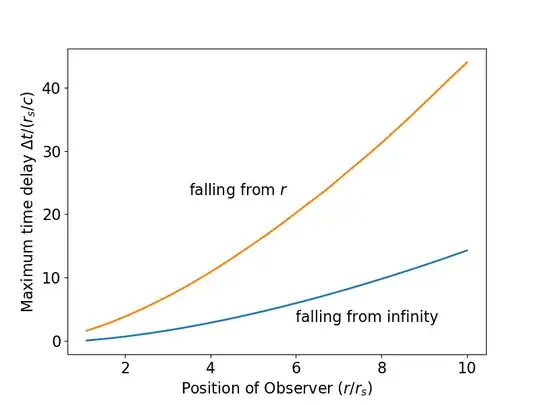In this question/answer Does someone falling into a black hole see the end of the universe?, it is stated that an observer free falling toward/into a black hole will not see the end of the Universe because the worldline of that observer in Kruskal coordinates crosses the horizon and terminates at the event horizon without seeing all infalling light signals, which would be required in order for that observer to see the end of the Universe.
But outside the horizon, where Schwarzschild coordinates are applicable, it takes an infinite amount of coordinate time (though not proper time) to reach the horizon and therefore, in those coordinates outside the horizon, wouldn't all infalling light signals intersect the freefalling observer's path before or at the horizon (since the amount of Schwarzschild coordinate time for the light signal to reach the horizon must also be infinite)?
Given that a timelike free falling observer must follow a path defined such that $\left|\frac{dr}{dt}\right|$ of that path is always less than the $\left|\frac{dr}{dt}\right|$ of the worldline of any given light signal at a given $r$, it seems to me that all light signals should intersect the free falling observer's worldline before reaching the horizon (since an infinite amount of coordinate time passes before either reaches the horizon).
Why is incorrect to interpret the consequence of the Schwarzschild coordinates (which are applicable for $r>r_s$) in this way?
Note added in edit by RJ: For a free-falling observer $$\left(\frac{dr}{dt}\right)_{\rm obs} = -\left(1 - \frac{r_s}{r}\right)\left(\frac{r_s}{r}\right)^{1/2},$$ (in $c=1$ units), whereas the null geodesic for light has $$ \left(\frac{dr}{dt}\right)_{\rm light} = -\left(1 - \frac{r_s}{r}\right) $$ Hence for $r>r_s$ and $r_{\rm light} \geq r_{\rm obs}$, $$\left|\frac{dr}{dt}\right|_{\rm light} > \left|\frac{dr}{dt}\right|_{\rm obs}$$ and the light always "catches" the falling observer.
